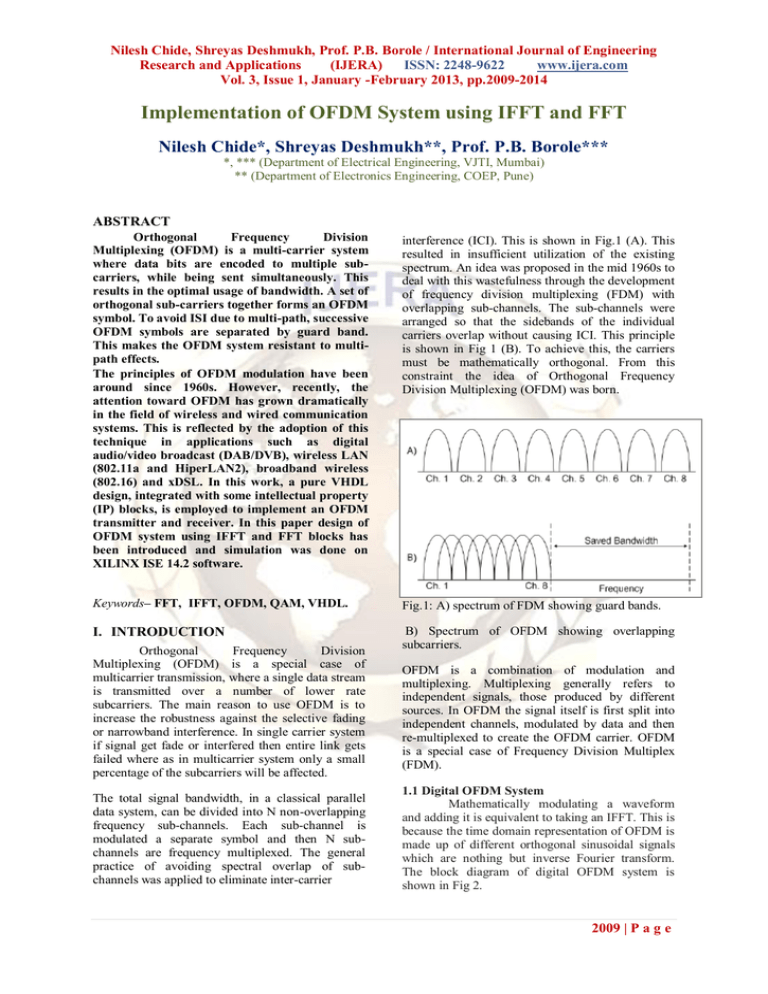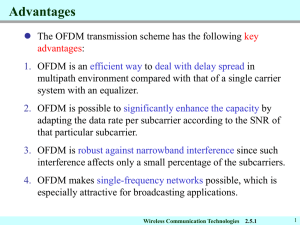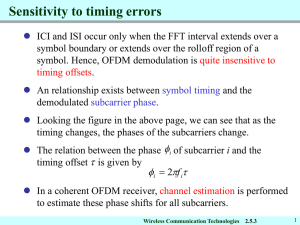Implementation of OFDM System using IFFT and FFT
advertisement

Nilesh Chide, Shreyas Deshmukh, Prof. P.B. Borole / International Journal of Engineering Research and Applications (IJERA) ISSN: 2248-9622 www.ijera.com Vol. 3, Issue 1, January -February 2013, pp.2009-2014 Implementation of OFDM System using IFFT and FFT Nilesh Chide*, Shreyas Deshmukh**, Prof. P.B. Borole*** *, *** (Department of Electrical Engineering, VJTI, Mumbai) ** (Department of Electronics Engineering, COEP, Pune) ABSTRACT Orthogonal Frequency Division Multiplexing (OFDM) is a multi-carrier system where data bits are encoded to multiple subcarriers, while being sent simultaneously. This results in the optimal usage of bandwidth. A set of orthogonal sub-carriers together forms an OFDM symbol. To avoid ISI due to multi-path, successive OFDM symbols are separated by guard band. This makes the OFDM system resistant to multipath effects. The principles of OFDM modulation have been around since 1960s. However, recently, the attention toward OFDM has grown dramatically in the field of wireless and wired communication systems. This is reflected by the adoption of this technique in applications such as digital audio/video broadcast (DAB/DVB), wireless LAN (802.11a and HiperLAN2), broadband wireless (802.16) and xDSL. In this work, a pure VHDL design, integrated with some intellectual property (IP) blocks, is employed to implement an OFDM transmitter and receiver. In this paper design of OFDM system using IFFT and FFT blocks has been introduced and simulation was done on XILINX ISE 14.2 software. interference (ICI). This is shown in Fig.1 (A). This resulted in insufficient utilization of the existing spectrum. An idea was proposed in the mid 1960s to deal with this wastefulness through the development of frequency division multiplexing (FDM) with overlapping sub-channels. The sub-channels were arranged so that the sidebands of the individual carriers overlap without causing ICI. This principle is shown in Fig 1 (B). To achieve this, the carriers must be mathematically orthogonal. From this constraint the idea of Orthogonal Frequency Division Multiplexing (OFDM) was born. Keywords– FFT, IFFT, OFDM, QAM, VHDL. Fig.1: A) spectrum of FDM showing guard bands. I. INTRODUCTION B) Spectrum of OFDM showing overlapping subcarriers. Orthogonal Frequency Division Multiplexing (OFDM) is a special case of multicarrier transmission, where a single data stream is transmitted over a number of lower rate subcarriers. The main reason to use OFDM is to increase the robustness against the selective fading or narrowband interference. In single carrier system if signal get fade or interfered then entire link gets failed where as in multicarrier system only a small percentage of the subcarriers will be affected. The total signal bandwidth, in a classical parallel data system, can be divided into N non-overlapping frequency sub-channels. Each sub-channel is modulated a separate symbol and then N subchannels are frequency multiplexed. The general practice of avoiding spectral overlap of subchannels was applied to eliminate inter-carrier OFDM is a combination of modulation and multiplexing. Multiplexing generally refers to independent signals, those produced by different sources. In OFDM the signal itself is first split into independent channels, modulated by data and then re-multiplexed to create the OFDM carrier. OFDM is a special case of Frequency Division Multiplex (FDM). 1.1 Digital OFDM System Mathematically modulating a waveform and adding it is equivalent to taking an IFFT. This is because the time domain representation of OFDM is made up of different orthogonal sinusoidal signals which are nothing but inverse Fourier transform. The block diagram of digital OFDM system is shown in Fig 2. 2009 | P a g e Nilesh Chide, Shreyas Deshmukh, Prof. P.B. Borole / International Journal of Engineering Research and Applications (IJERA) ISSN: 2248-9622 www.ijera.com Vol. 3, Issue 1, January -February 2013, pp.2009-2014 2.1 Modulator (QAM) Presented system uses QAM modulation so 16 constellation points are used. To have different constellation values data is divided in groups of 4 bits each and convert that binary code to gray code for better accuracy. Upper two bits are used for imaginary number and lower two bits are used to denote real number. Fig.2: Digital implementation of OFDM system using IFFT and FFT Since the OFDM signal is in time domain, IFFT is the appropriate choice to use in the transmitter, which can be thought of as converting frequency domain samples to time domain samples. Fig. 2 illustrates how the use of IFFT in the transmitter eliminates the need for separate sinusoidal converters. IFFT and FFT blocks in the transmitter are interchangeable as long as their duals are used in receiver. II. IMPLEMENTATION According to given in Fig. 3, we have to implement the OFDM block by block and finally interconnect all of them together to form complete OFDM circuit. The simulation results in XILINX ISE 14.2 software of Modulator, Demodulator, FFT and IFFT block are shown in Fig. 6, 7, 8, respectively at the end of paper. Fig. 4: Block Diagram of QAM Table 1 Some Bit combinations and corresponding constellation Bit combination Gray Code Constellation value Nature of value 0000 0000 -3j-3 Complex 0011 0010 -3j+3 Complex 0100 0110 -j+3 Complex 1011 1110 J+3 Complex 1101 1011 3j+1 Complex 0111 0100 -j-3 Complex 1000 1100 j-3 Complex Different bit combinations and corresponding constellation are shown in Table 2. In above modulation scheme, bit combination (D3D2 or D1D0) 00 corresponds to -3, 01 corresponds to -1, 11 correspond to 1, 10 correspond to 3. Fig.3: Block Diagram of OFDM system To achieve this, a separate process is written in VHDL code. “Case” statement is used to check the combinations. As constellation is complex number, two different arrays are required to store real part and imaginary part separately. In the process for constellation mapping, case statement checks the bit 2010 | P a g e Nilesh Chide, Shreyas Deshmukh, Prof. P.B. Borole / International Journal of Engineering Research and Applications (IJERA) ISSN: 2248-9622 www.ijera.com Vol. 3, Issue 1, January -February 2013, pp.2009-2014 combinations and according to bit combinations one of the 4 values (-3,-1, 1, 3) is assigned in imaginary or real output respectively. 2.2 Inverse Fast Fourier Transform (IFFT) Initially carrier bank generating a set of subcarriers was necessary for OFDM in conventional or analogue approach. Each subcarrier was modulated with a constellation decided by bit combination, but this approach made system bulky and costlier. So to make system digital, simple, cheap, and efficient IFFT is being used. A stepwise implementation of butterfly diagram is done in this algorithm. Radix-2 Decimation-in-time (DIF) IFFT is implemented in this algorithm. Different procedures and operations are done to achieve this. In Fig. 4 the basic butterfly unit for the radix-2 IFFT algorithm is shown. Fig. 5(a): Decimation-In-Time IFFT Fig. 5(b): Decimation-In-Frequency IFFT 2.3 FFT and Demodulator For FFT inverse process of IFFT and for Demodulation inverse process of Modulation is used. In this design at FFT, if its output 2.999 then FFT shows it as a 2 instead of 3. Care of this type of problems is taken by demodulator , it gives output as 3 for input 2 or 3. III. CONCLUSION The main aim of the project is to implement the core signal processing blocks of OFDM system using VHDL language. The different blocks of OFDM system such as QAM Modulator, 8-IFFT, 8-FFT and Demodulator is designed on Xilinx project navigator. These blocks are simulated on XILINX 14.2 ISE Design Suite, tested for different data patterns and results are compared with theoretical expected results. IV. FUTURE WORK The results are matching with expected results. The steps involved in implementation of the communications system on hardware have to learn. In this project OFDM system is simulated using 8 subcarriers i.e. with 8 point IFFT and FFT. This is very basic implementation and has advantage of less processing time requirement and complexity but this system has less spectral efficiency. The spectral efficiency can be increased by increasing the number of subcarriers i.e. by using 64 point IFFT and FFT. REFERENCES [1] A reference Joaquin Garcia, Rene Cumplido,“On the design of an FPGA-based OFDM modulator for IEEE 802.16.”, proceedings of 2005 international conference on reconfigurable computing and FPGAs. [2] Farzad Manavi, Yousef R. Shayan, “Implementation of an OFDM modem for the physical layer of IEEE 802.11a standard based on Xilinx Virtex-II FPGA.”,a 0-78038255-2/04/$20.00 2004 IEEE. [3] R.Van Nee, R. Prasad Publication by Artech House,“OFDM for wireless Multimedia Communications.”, e-book. [4] R.W. Chang, “Synthesis of band limited Orthoganal Signals for Multichannel data transmission,” Bell syst. Tech. J., Vol. 45, pp. 1775-1776, December.1996. [5] Salzberg, B. R., “Performance of an efficient parallel data transmission system,” IEEE transaction comm., Vol. COM-15, pp. 805813, December. 1967. [6] Mosier, R. R., and R. G. Clabaugh, “Kineplex, a bandwidth efficient binary transmission system,” AIEE Trans. Vol. 76. pp., 723-728, January. 1958. [7] Weinstein, S. B., and P. M. Ebert, “Data transmission by Frequency Division Multiplexing using the DFT,” IEEE Trans. Comm., Vol. COM – 19, pp. 628-634, October.1971. [8] Horosaki B., “An orthogonally multiplexed QAM system using the DFT,” IEEE Trans. Comm. Vol. COM-29, pp. 982-989, July 1981. [9] “Design & Implementation of OFDM base band for The IEEE 802.11a WLAN” by Chandrashekhar Kukade, R. M. Patrikar, R. B. Deshmukh(VNIT Nagpur). [10] Article “Implementation of FFT and IFFT algorithms in FPGA” by Ilgaz Az and Suhap Sahin 2011 | P a g e Nilesh Chide, Shreyas Deshmukh, Prof. P.B. Borole / International Journal of Engineering Research and Applications (IJERA) ISSN: 2248-9622 www.ijera.com Vol. 3, Issue 1, January -February 2013, pp.2009-2014 Fig.6: Simulation result of Modulator Fig. 7(A): Input to IFFT 2012 | P a g e Nilesh Chide, Shreyas Deshmukh, Prof. P.B. Borole / International Journal of Engineering Research and Applications (IJERA) ISSN: 2248-9622 www.ijera.com Vol. 3, Issue 1, January -February 2013, pp.2009-2014 Fig. 7(B): Output to IFFT Fig. 8(A): Input to FFT 2013 | P a g e Nilesh Chide, Shreyas Deshmukh, Prof. P.B. Borole / International Journal of Engineering Research and Applications (IJERA) ISSN: 2248-9622 www.ijera.com Vol. 3, Issue 1, January -February 2013, pp.2009-2014 Fig. 8(B): Output to FFT 2014 | P a g e



